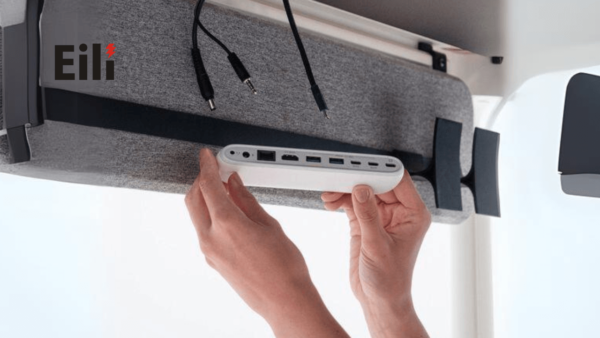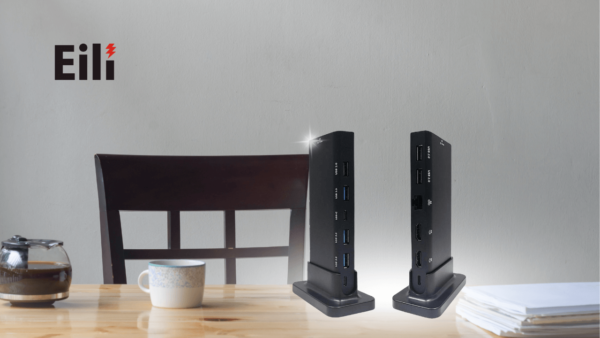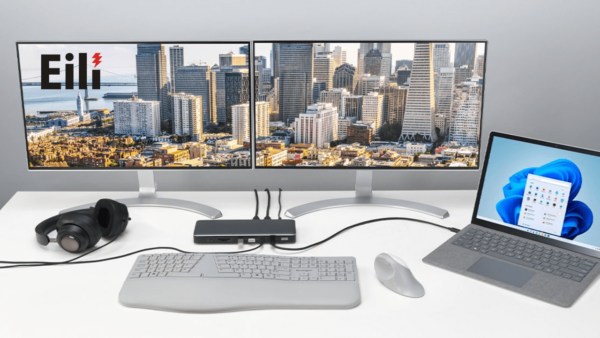USB Docking Station
Top 5 factors need to considers when Choosing the Best Laptop Docking Station in 2024
In today’s fast-paced and mobile-driven world, laptops serve as the primary computing devices for professionals, students, and casual users alike. Yet, with their portability comes a limitation: fewer ports and connection options compared to traditional desktop setups. This is where docking stations come into play. Let’s explores everything you need to know about docking stations, including their benefits, key features, how they work, and crucial factors to consider when choosing one that best suits your needs with Eili Industrial.
Understanding Docking Stations: What Are They?
Docking stations, often referred to as universal port replicators, are external hardware devices designed to create a bridge between your laptop and various desktop peripherals.

Definition and Purpose
The primary purpose of a docking station is simple: it allows users to hook up multiple devices such as monitors, hard drives, printers, and more, using just one connection to the laptop. Think of it as a centralized hub that not only simplifies connections but also enhances productivity by giving you immediate access to a plethora of ports.
How They Work
Docking stations connect to your laptop via USB-C, Thunderbolt, or USB 3.0 cables. Once connected, they route all peripheral devices through a single cable. This arrangement eliminates the clutter of wires typically associated with multiple devices. Moreover, many modern docks offer power delivery, meaning they can charge your laptop while providing connectivity.
Physical Design
Most docking stations have a stationary design, serving as a permanent feature on your desk. They come in various shapes, sizes, and configurations, catering to different user preferences and space requirements. Whether you’re a student with limited desk space or a professional with a dual-monitor setup, there’s likely a port replicators tailored to your needs.
Benefits of Using Docking Stations
Investing in a docking station offers numerous advantages that make it a worthwhile addition to your workspace.
Streamlined Workspace
One of the most appealing benefits of using a port replicator is simplified cable management. With just a single cable connecting your laptop to the dock, you eliminate the unsightly mess of tangled cords that often plague workspaces. This streamlined approach not only enhances aesthetics but also promotes efficiency—less time spent untangling cords means more time focusing on the tasks at hand.

Multi-Display Support
For those who thrive on multitasking, port replicators enable the connection of multiple monitors. This capability significantly increases screen real estate, allowing you to extend your display across several screens, ideal for data analysis, programming, or design tasks. You can keep your email client open on one monitor while working on a project in another, creating a frictionless workflow.
Enhanced Connectivity Options
A docking station typically includes a variety of ports, from USB and HDMI to Ethernet and audio jacks. This versatility allows you to connect a range of devices simultaneously, from printers to external storage devices. By expanding your connectivity options, it makes it easy to maintain a productive environment without the hassle of constantly plugging and unplugging devices.
Portable Flexibility
In our increasingly mobile lives, flexibility is key. Docking stations provide the ability to set up a complete workstation quickly, whether in the office, at home, or even in a coworking space. Simply undock your laptop and take it with you, knowing that you can re-establish your workspace just as effortlessly when you return.
Key Features to Look For in a Docking Station
When shopping for a docking station, it’s essential to look beyond basic port availability. Here are some critical attributes that can significantly impact your experience.
Types and Number of Ports
Consider what types of devices you’ll be connecting to . While USB ports are standard, look for docks that also offer HDMI, DisplayPort, and other video outputs. The right mix of ports will ensure you can connect all your essential accessories without limitations.
Power Delivery Capability
If you want to reduce the number of cables you manage, choose a dock station that supports power delivery. This feature allows the dock to charge your laptop while also connecting to other devices, ensuring you’re always powered up and ready to go.
Display Support
Evaluate your monitor setup. If you plan to use multiple displays, ensure it can support your needs, whether that’s dual 4K monitors or a combination of different resolutions. Proper display support not only enhances productivity but also improves the overall visual experience.
Device Compatibility
Before investing in a docking station, verify its compatibility with your laptop’s ports and operating system. Some port replicator may prioritize certain brands or models, leading to potential issues if your device isn’t supported. Research customer reviews and product specifications to avoid any connectivity headaches.
Exploring Different Types of Docking Stations
Understanding the various types of docking stations available can help you identify which model aligns best with your needs.
USB Docking Stations
USB port replicators are among the most common types due to their widespread compatibility. They typically connect via USB 3.0 or USB-C, offering enhanced data transfer speeds and the ability to charge devices. Higher-end models may also support dual monitor setups and provide additional features like audio output.
Thunderbolt Docking Stations
Thunderbolt dock stations leverage Intel’s high-speed technology, allowing for rapid data transfer rates. Ideal for creative professionals who require blazing fast performance, these docks can handle multiple 4K displays and deliver significant power to connected devices. However, they tend to be pricier than their USB counterparts.
Hybrid Docking Stations
Hybrid docking stations aim to provide the best of both worlds by offering a combination of USB and Thunderbolt connectivity. These stations cater to a broader range of devices and applications, making them suitable for various user scenarios.

Standalone vs. Port Replicators
Standalone docking stations come with onboard processing capabilities, enabling advanced functionalities such as video conversion. In contrast, port replicators primarily focus on port expansion and lack independent processing. Depending on your needs, either option could be beneficial.
Choosing the Right Docking Station for Your Needs
With so many options available, selecting the ideal docking station requires careful consideration of your specific needs and workspace setup.
Assessing Your Workspace
Begin by evaluating your current workspace situation. How much room do you have for a docking station? Consider the layout of your desk and whether you prefer a vertical or horizontal design. If you’re confined to a small area, a compact dock might be the best choice.
Analyzing Your Peripheral Devices
Take stock of the devices you regularly use. Will you be connecting multiple monitors or just a few USB peripherals? Ensuring that yours can accommodate all necessary devices will ultimately save you time and frustration down the line.
Budget Considerations

Budget plays a significant role in your decision-making process. High-end docking stations packed with features may come with a higher price tag. However, there are budget-friendly options that still provide essential functionality. Prioritize the features that matter most to you and look for quality options within your price range.
Future-Proofing Your Investment
Technology evolves rapidly, and it’s wise to consider future-proofing your investment. Opt for a docking station that can accommodate evolving technology trends, such as increased display resolutions or faster data transfer rates. This foresight will ensure that your docking station remains relevant for years to come.
Conclusion
As we progress further into 2024, the importance of docking stations continues to grow, bridging the gap between mobility and powerful computing. By understanding their benefits, key features, various types, and factors port replicator can enhance your productivity and streamline your workspace, offering a seamless transition between mobile and stationary work. Embrace this invaluable innovation, and elevate your laptop experience to new heights.
Related Articles:
- USB Hub Vs. Docking Station: 5 Differences You Need To Know
- Comparing USB-C Docking Stations: The Best Choices for MacBook and Dell Laptops
- Eili and Wukong: A New Power, A New Experience for Your Workspace
Connect with Eili:


